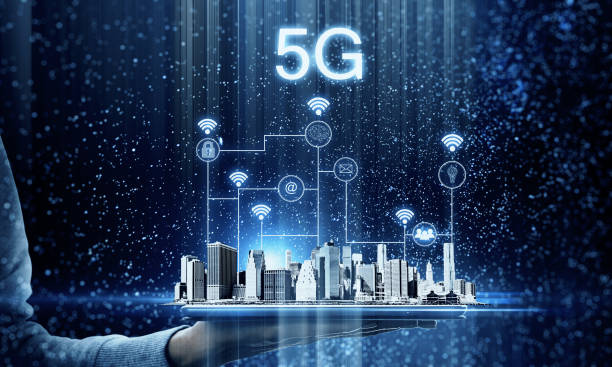The 5G wireless technology is coming, as are the changes in tech and industry.
- The 5G wireless standard will bring gigabit speeds to the masses, new devices, and lower latency for customers and businesses.
- 5G promises better integration for IoT sensors and self-driving vehicles.
- All significant U.S. telecommunications networks are expanding the 5G infrastructure.
- This article is intended for consumers and small business owners interested in 5G technology and its differences from previous wireless technologies.
The 5G network promises to usher in a new era of gigabit speed for all. The consumer market is primarily concerned with the ability to download movies and games in seconds. However, small businesses are also affected by this.
Each wireless carrier is expanding its 5G footprint, and the 5G rollout has gained speed. Cell phone manufacturers are also increasing the number of 5G-capable products. Gartner reported that global demand for 5G smartphones was 32 times greater in 2021 compared to 2019. This indicates a rapid adoption rate among consumers.
What 5G will bring
5G promises gigabit speeds. This is a great thing, but it’s not the only change that 5G brings.
Latency is defined as the time taken for a packet of data to travel from one place to another. The less latency, the more devices can communicate. It is crucial for businesses that rely on IoT technology (Internet of Things) to connect multiple devices and sensors to provide insights into business operations, product placement and to communicate data. A report by Ericsson states that there will be 30 million IoT devices in 2027. Of these, 5.5 billion will use cellular connections.
What is the difference between 5G and 4G?
Some of the underlying technologies make 5G unique. Transmit at these bands; the previous technology could not do so due to power and equipment limitations. Ericsson stated that its “This is 5G” report for 2021 indicated that 5G networks could achieve peak upload and download speeds of 10 and 20 Gbps, respectively. This compares with 1 and 0.22 Gbps in 4G networks.
5G promises to be different from 4G on the scale front. According to an Ericsson report, 5G networks are expected to have latencies as low as one millisecond compared to 10 milliseconds for 4G networks. In addition, 5G is expected to provide businesses with significant economic benefits by allowing them to handle exponentially more IoT devices. While 4G networks can manage 250 IoT devices in a square mile, 5G is expected to support 2.5 million devices.
This will primarily be due to the differences between 4G and 5G networks. While 5G still uses radio waves, as 2G and 3G do, it also uses low, mid, and high-frequency radio waves. The 5G core integrates these waves, allowing for new technologies like network slicing or edge computing.
How to get 5G
All major U.S. mobile carriers are in the process of expanding their 5G network infrastructure. Carriers have also launched 5G networks for homes and businesses to deliver 5G speeds via wireless 5G networks. These plans benefit consumers and businesses living in areas without high-speed internet.
Verizon 5G Networks
Verizon launched its 5G Ultra Wideband Network in selected cities across the U.S., which, according to the company, is up to 10 times faster than the previous 4G network. Verizon also launched a 5G nationwide network, which covers more than 2,700 cities in the U.S. and over 200 million Americans. Verizon 5G Nationwide speeds are comparable to those of 4G LTE. Verizon claims that the network is continually improving.
Verizon also launched the 5G Business Unlimited and Home Internet Unlimited plans. The company claims that its programs will have latency that will drop to milliseconds so that that lag will be unnoticeable.
AT&T 5G network
AT&T launched its mobile network, 5G, making similar promises that this connectivity would be crucial for consumers and businesses. AT&T, like Verizon, offers a network that covers 255 million Americans. It also has a network with higher speeds and better connectivity.
AT&T Business also offers multiple 5G solutions for business users.
What industries will be affected first by 5G?
Low latency is critical to new tech innovations beyond consumer electronics, such as artificial intelligence and automation.
5G will be critical to the future of emerging technology services. Chinese tech giant Baidu recently announced its plans for autonomous vehicles. 5G technology is critical to the success of these vehicles. Self-driving cars of the future will depend on 5G connections in scenarios requiring constant network connectivity.
Medicine, banking, and automation are other fields that will require 5G connectivity. Cloud hosting is also expected in I.T. infrastructures, which will reduce the need for hardware and transform the workforce. Virtualization may be reconsidered by companies that hesitated in the past due to the 5G speed and latency.
Small businesses can benefit from 5G.
Businesses need to consider how 5G can benefit them as telecom companies develop the infrastructure for 5G. 5G is essential for fields such as automation, A.I., machine learning, and cloud computing. It would help to start thinking about how these fields may affect your business and workforce in the coming years.

